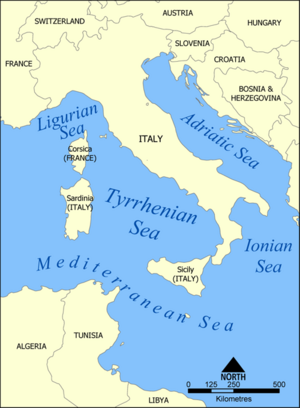Tyrrhenian Sea

The Tyrrhenian Sea (Italian: Mar Tirreno) is part of the Mediterranean Sea off the western coast of Italy.
Contents |
Geography
The sea is bounded by Corsica and Sardinia (to the west), Tuscany, Lazio, Campania, Basilicata and Calabria (to the east) and Sicily (to the south).
The maximum depth of the sea is 3,785 metres (12,418 ft).
The Tyrrhenian Sea is situated near where the African and European Plates meet; therefore mountain chains and active volcanoes such as Mount Marsili are found in its depths. The eight Aeolian Islands are located in the southern part of the sea, north of Sicily.
Extent
The International Hydrographic Organization defines the limits of the Tyrrhenian Sea as follows:[1]
In the Strait of Messina. A line joining the North extreme of Cape Paci (15°42'E) with the East extreme of the Island of Sicily, Cape Peloro (38°16'N).
On the Southwest. A line running from Cape Lilibeo (West extreme of Sicily) to the South extreme of Cape Teulada (8°38'E) in Sardinia.
In the Strait of Bonifacio. A line joining the West extreme of Cape Testa (41°14'N) in Sardinia with the Southwest extreme of Cape Feno (41°23'N) in Corsica.
On the North. A line joining Cape Corse (Cape Grosso, 9°23'E) in Corsica, with Tinetto Island () and thence through Tino and Palmaria islands to San Pietro Point () on the coast of Italy.
Exits
There are five exits from the Tyrrhenian Sea (north to south):
- The Corsica Channel between Tuscany and Corsica, about 80 km (49.7 mi) wide.
- The Strait of Bonifacio between Corsica and Sardinia, 11 km (6.8 mi) wide.
- The Sardinian Channel between Sardinia and Tunisia, about 200 km (124 mi) wide.
- The Strait of Sicily between Tunisia and Sicily, about 160 km (99.4 mi) wide.
- The Strait of Messina between Sicily and Calabria on the toe of Italy, 3 km (1.8 mi) wide.
Basins
The Tyrrhenian Sea is divided into two basins (or plains), the Vavilov plain and the Marsili plain. They are separated by the undersea ridge known as the Issel Bridge, after Arturo Issel.[2]
Name
Its name derives from the Greek name for the Etruscans, who were said to be emigrants from Lydia and led by the prince Tyrrhenus.[3] The Etruscans settled along the coast of modern Tuscany and referred to the water as the "Sea of the Etruscans".
Winds
In Greek mythology, it is believed that the cliffs above the Tyrrhenian Sea housed the four winds kept by Aeolus. Winds are Mistral from the Rhône valley, Libeccio from the south-west, Sirocco and Ostro from the south.
References
- ↑ "Limits of Oceans and Seas, 3rd edition". International Hydrographic Organization. 1953. http://www.iho-ohi.net/iho_pubs/standard/S-23/S23_1953.pdf. Retrieved 6 February 2010.
- ↑ Sartori, Renzo (2003) "The Tyrrhenian back-arc basin and subduction of the Ionian lithosphere" Episodes 26(3): pp.217-221, p. 217
- ↑ http://www.sjsu.edu/faculty/watkins/etruscans.htm
|
||||||||||||||||||||
|
||||||||||||||||||||